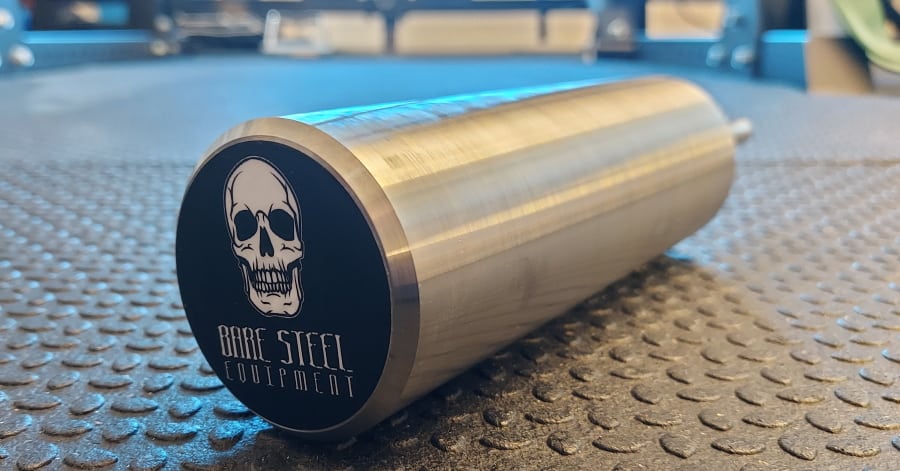The Stacked Weight Pin is an innovative gym accessory that will change the way you use selectorized weight machines. It’s designed to add Olympic plates to the weight stack to increase the maximum weight possible.
It separates itself from competing options by offering premium features and the option to upgrade its aesthetics with custom coatings.
My Bare Steel Equipment Stacked Weight Pin review will cover all there is to know about this weight stack plate holder pin.
Table of Contents
What Is the Stacked Weight Pin?
The Stacked Weight Pin from Bare Steel Equipment is a weight stack adapter pin. You use it to modify a weight stack so you can load on Olympic weight plates.
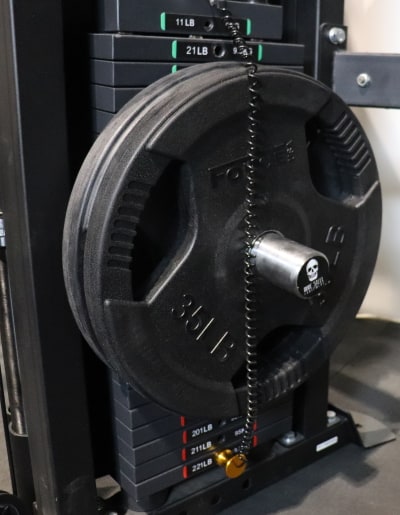
This is helpful if you outgrow a machine and become too strong for even the highest weight stack setting.
The Stacked Weight Pin is a simple design at its core. All of the models have two major components:
- A steel rod, or pin, measuring either 8mm or 10mm in diameter. This is the part that inserts into the weight stack plate holes. The rod length is 3.65 inches or 4 inches. I’ll discuss which rod diameter and length you should choose later on.
- A sleeve that measures just under 2 inches in diameter (49.5mm or 1.95 in to be exact). This diameter allows it to accept even calibrated steel powerlifting plates, which have a tighter hole diameter (50.4mm or sometimes 50mm) than most other plates. The sleeve length measures either 6 inches or 3 inches depending on the model.
It also has magnets built into the back of the sleeve, which is a very cool feature. I’ll discuss the magnets in a later section of this Stacked Weight Pin review.
Other Uses: Adder Weight for Incremental Gains
The Stacked Weight Pin has a second, not-so-obvious use. You can stick it in the stack without any plates on it to use it as an “adder weight.”
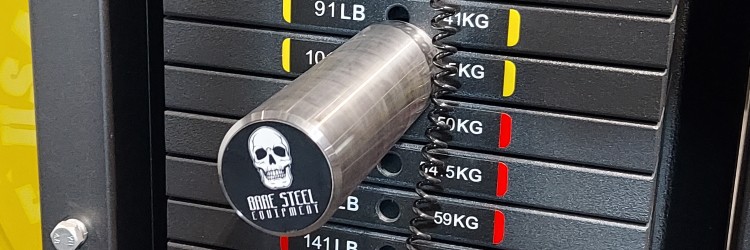
The Stacked Weight Pin weighs about 5 lbs on its own. This is the perfect weight for making incremental progress since most weight stacks go up in 10 lb increments. You can slide a 2.5 lb plate on for even further incremental progress.
You can do the same with Short Stack Pin, which weighs 2.5 lbs. If this isn’t a big enough increment for you, you can add a 2.5 lb or 5 lb plate.
This is one area where the Stacked Weight Pin and Short Stack Pin excel over the GymPin. While the GymPin can also be used as an adder weight, it is much lighter (~1 lb for the shortest model, ~2 lbs for the medium length model and ~2.5 lbs for the extra long one). The heavier weights of the Bare Steel Equipment pins are more convenient when just sticking the empty pin in the stack.
Stacked Weight Pin Models & Specs
There are 3 different Stacked Weight Pin models that Bare Steel Equipment offers:
- 8mm Stacked Weight Pin
- 10mm Stacked Weight Pin
- Short Stack Weight Pin (10mm)
I’ll go over the specs and dimensions for each model below. Before you buy your Stacked Weight Pin, you should use the dimensions to check if the Stacked Weight Pin will be compatible with the weight stack machine(s) you plan to use it on.
8mm Stacked Weight Pin
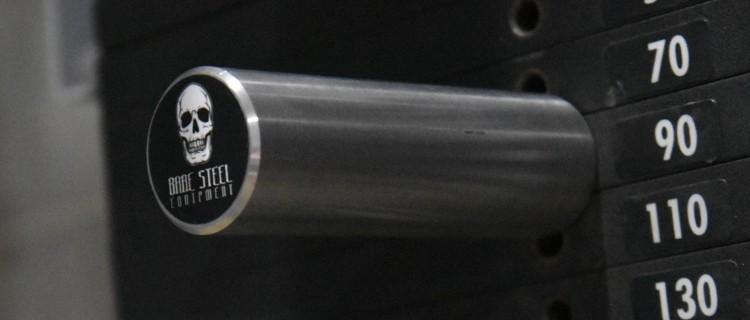
Here’s the specs and dimensions for the 8mm Stacked Weight Pin:
- Sleeve diameter: 1.95 in (49.5mm)
- Rod/pin diameter: 8mm
- Sleeve length: 6 in
- Rod/pin length: 3.65 in
- Magnet Pull Force: 21 lbs
- Total length: 9.65 in
- Weight: Approx. 5 lbs 3 oz (5.19 lbs)
- Note: 5 lbs 3 oz is the exact weight of the 10mm rod Stacked Weight Pin with a 4 in rod length. As such, this 8mm Stacked Weight Pin weighs slightly less since it has an 8mm rod instead of a 10mm rod and a 3.65 in rod length instead of a 4 in rod length. However, the difference is almost negligible
10mm Stacked Weight Pin
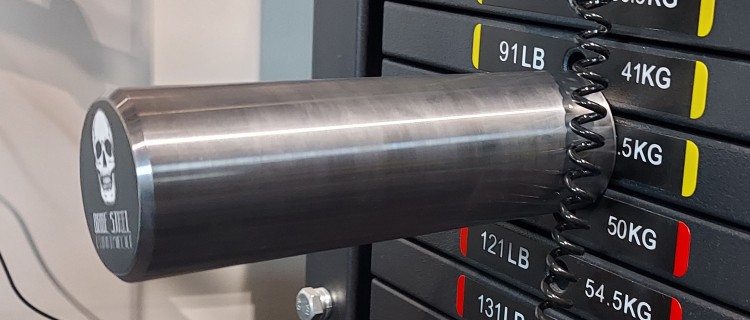
Here’s the specs and dimensions for the 10mm Stacked Weight Pin:
- Sleeve diameter: 1.95 in (49.5mm)
- Rod/pin diameter: 10mm
- Sleeve length: 6 in
- Rod/pin length: 3.65 in or 4 in
- Magnet Pull Force: 21 lbs
- Total length: 9.65 in or 10 in
- Weight: 5 lbs 3 oz (5.19 lbs) for the 4 in rod version; the 3.65 in rod version will weigh just a hair less
Short Stack Weight Pin
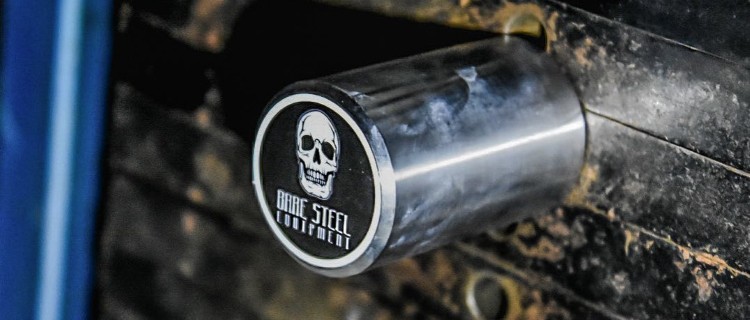
Here’s the specs and dimensions for the Short Stack Weight Pin:
- Sleeve diameter: 1.95 in (49.5mm)
- Rod/pin diameter: 10mm
- Sleeve length: 3 in
- Rod/pin length: 3.65 in or 4 in
- Magnet Pull Force: 21 lbs
- Total length: 7 in or 6.65 in
- Weight: 2 lbs 10 oz (2.63 lbs) for the 4 in rod version; the 3.65 in rod version will weigh just a hair less
How Does the Stacked Weight Pin Work?
Using the Stacked Weight Pin is a simple process. It’s as easy as 1, 2, 3:
- Insert the rod into one of the holes on the weight stack.
- Slide the desired amount of weight plates onto the sleeve (assuming you’re not using the empty pin as an incremental adder weight) and add a barbell collar if needed.
- Do the exercise.
Take a look at the video clip below of me using the 10mm Stacked Weight Pin on cable rows:
Side Note: In the video above, I’m using 35 lb plates as the largest plate. I’ll talk about why I’m not using the larger-diameter 45 lb plates in a later section on compatibility.
Magnets
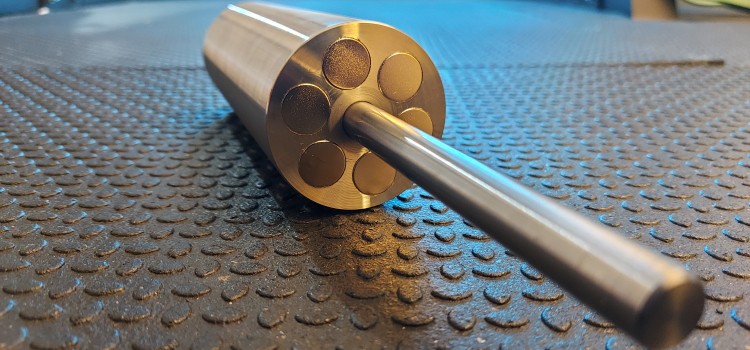
Magnets are the standout feature that sets the Stacked Weight Pin apart from the competing GymPin.
There are 6 circular magnets built into the base of the sleeve in a six-shooter, or revolver-style, pattern.
The purpose of these is to magnetically connect the Stacked Weight Pin’s sleeve base to the weight stack. The magnets collectively have 21 lbs of magnetic force. This provides a solid connection to the stack. You have to give it a concerted ‘yank’ to remove it from the stack.
If you load enough weight on the Stacked Weight Pin, the magnetic connection will break. But it is nonetheless a useful feature, especially at lighter to moderate weights.
When I was testing the Stacked Weight Pin with 90 lbs (two 45s), the plates were still staying mostly in place. When looking behind the plates, I could see the connection was still (partially) there — The top of the sleeve had already slightly disconnected from the stack, but the bottom magnets appeared to be somewhat in contact. If I put much more weight on, the plates would start to slide.
However, when I compared it to the magnet-less GymPin, the plates would already be sliding with this amount of weight on.
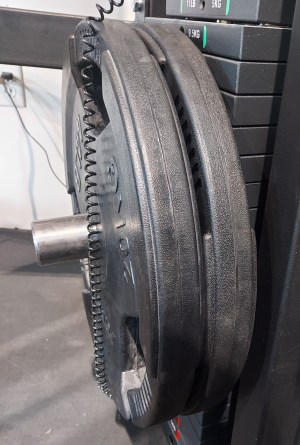
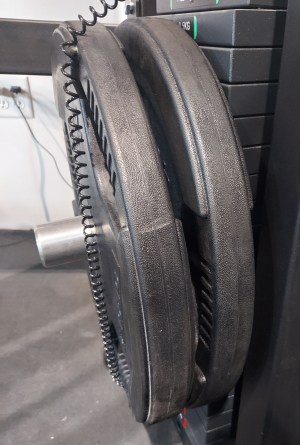
In any case, if you have enough weight on, it’s a good idea to use a barbell collar. Sliding may start if you move the weight stack up and down fast enough during the exercise.
Finish Options
The optional finishes are another area where the Bare Steel Equipment Stacked Weight Pin stands out from the competing GymPin.
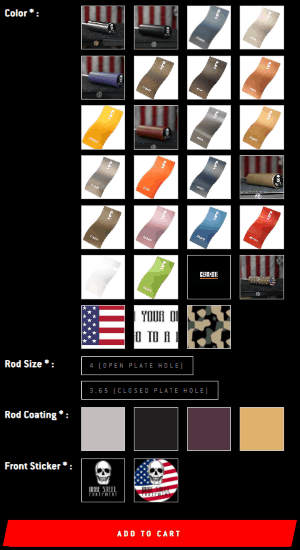
The GymPin is currently only available in a bare steel finish.
The Stacked Weight Pin also comes in bare steel as the default option. However, it has a plethora of optional finishes for both the sleeve and the pin/rod:
Optional Sleeve Finishes
Bare Steel Equipment offers a ton of different Cerakote finishes for the sleeve of the Stacked Weight Pin. Cerakote is a common barbell finish known for its extreme resistance to oxidation and protection against scratching and chipping.
Another big benefit is the many different color possibilities that can boost the aesthetics of your setup. There are a whopping 21 preset color options available for an extra $50. If the specific color or shade you want isn’t in that list of options, you can request a specific color for $90.
There are 3 preset multicolor patterns available for $175: stars & stripes pattern, camo pattern and a “We the People” pattern.
Lastly, you can request your own pattern or image (3 color max) for $175. This is a cool option if you want to display your own logo or a design that’s meaningful to you.
Optional Rod/Pin Finishes
For an extra $50, you can upgrade the rod to a Titanium Nitride (TiN) finish in satin black, rose or gold colors.
TiN doesn’t just give the rod a unique aesthetic. It also adds durability by protecting against scratching and oxidation. It also reduces friction when sliding the rod in and out of the stack. It’s a thin finish, adding just 3 micrometers of thickness, so it won’t mess with the fit of the rod in the weight stack holes.
How Much Weight Can You Add to the Stacked Weight Pin?
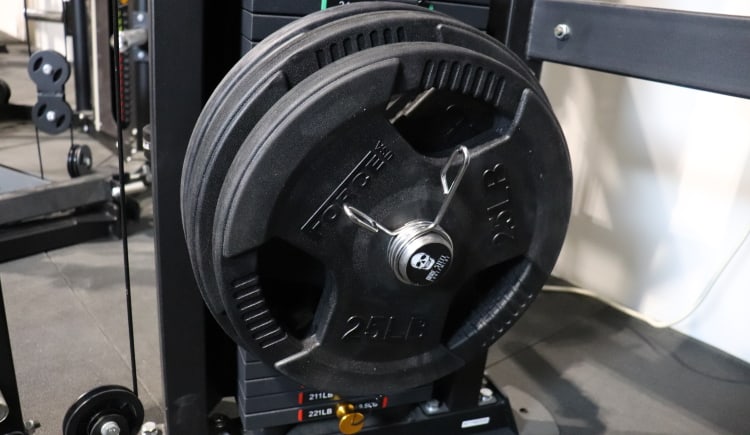
Bare Steel Equipment provides maximum weight capacities for the various models of the Stacked Weight Pin. They based these capacities on their own research of both the pin and cable machines. They determined these weight capacities provide the best result for both the pin and machine:
- 8mm Stacked Weight Pin: 100 lbs
- 10mm Stacked Weight Pin: 135 lbs
- Short Stack Weight Pin: 135 lbs
- Note: You won’t be able to physically fit this much weight on the short model unless you’re using thin steel powerlifting discs.
Of course, you may not be able to physically fit on the maximum weight recommendations depending on which plates you use. For example, with most bumper plates, you won’t be able to fit more than one or two 45 lb or 55 lb plates due to their thickness.
However, you’ll be able to hit or even exceed the max capacity (on the non-short models) if you have regular cast iron plates or even urethane-coated iron plates. If you have thin steel powerlifting discs, you could theoretically go much higher — But they do NOT recommend exceeding the weight capacities.
Note that when it comes to the amount of weight you can physically load on the sleeve, you should consider that you may need to use a barbell collar to keep the plates from sliding off. The more weight you put on, the more a collar becomes necessary. But if you have a workout partner, you can max out the sleeve length with plates and have your partner keep the plates on with their hands.
When it comes to the amount of weight on the sleeve, you should realize that this does not necessarily translate to the amount of resistance you add to the cable. That is the case if you have a 1:1 pulley ratio. But if you have a 2:1 or 4:1 ratio, then the resistance is half or a quarter of the weight added.
Safety Considerations
It’s reasonable to question safety when it comes to an attachment like this that adds weight to an already heavy weight stack.
Luckily, the standard weight rating for cables used in selectorized machines is 2000 lbs. This makes using the Stacked Weight Pin generally safe, even with a lot of extra weight added. This is because the total poundage is still considerably less than 2000 lbs.
That said, it’s possible for cables to snap even without added weight. Snapped cables are almost always due to a gradual wearing down of the cable. The signs of damage to the cable sheath or fraying of the cable itself are typically visible beforehand.
To be extra safe, inspect your cable system regularly for any signs of damage. Inspect the pulley wheels, too.
Ultimately, this is like any piece of gym equipment in that you use it at your own risk.
Who Should Buy a Stacked Weight Pin?
The Bare Steel Equipment Stacked Weight Pin only makes sense for a certain segment of lifters.
First off, if you don’t use any selectorized weight stack machines, you have no use for this accessory.
It’s also not a good purchase for most beginner lifters. Novices aren’t yet strong enough to be maxing out weight stacks. The only reason a beginner might want one would be to use it as incremental adder weight — but even then, beginners are usually gaining strength fast enough that they won’t plateau between weight stack settings for too long.
The Stacked Weight Pin does make sense if:
- At least one selectorized machine is a part of your training routine
- AND you’re strong enough that you regularly max out the stack
You should also consider buying a Stacked Weight Pin if you’re planning on buying a weight stack machine for your home gym but are concerned about the stack being too light for some exercises. You could buy a machine with a heavier stack, but that oftentimes adds a significantly higher price tag. The Stacked Weight Pin can fix the problem at a much more economical price. Just make sure it’s compatible first! (More on that below.)
Stacked Weight Pin Compatibility with Different Machines
Before you go and buy a Stacked Weight Pin, you need to make sure it’ll work on the selectorized machine(s) you’ll be training on.
Unfortunately, it doesn’t work on all machines. This can be for a number of reasons. I’ll discuss the most common compatibility issues below:
If you have a weight stack guard with an opening that closes off at the top, the pin may slam into it. Thus, you won’t be able to use the full range of motion on cable exercises.
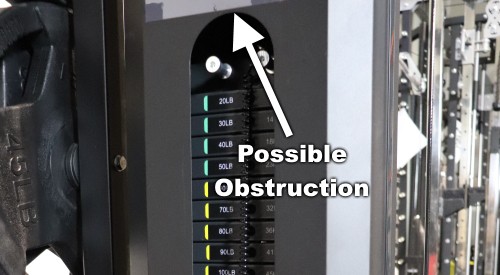
Another common compatibility issue is having other parts of the machine get in the way. Many times this can be part of the frame that the pin may hit when the stack is pulled up.
You may be able to bypass this problem by getting the Short Stack Weight Pin so you have enough clearance.
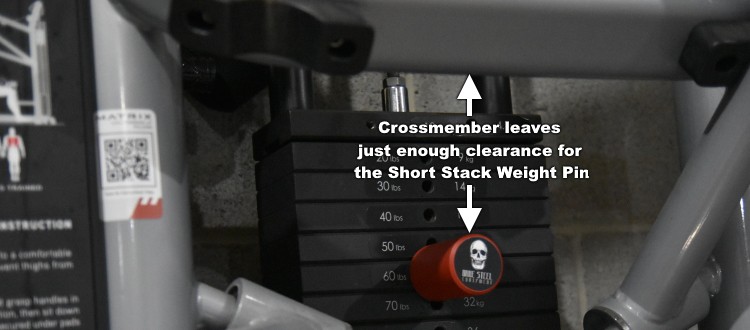
You also need to consider the amount of space the Olympic plates will take up. They can potentially create an obstruction with another part of the machine.
This was the issue I ran into when testing out the Stacked Weight Pin on the Force USA G6. The diameter of the 45 lb plates was just big enough that they hit the rear crossbeam when pulling the weight stack up. Luckily, the 35 lb and smaller plates had enough clearance.
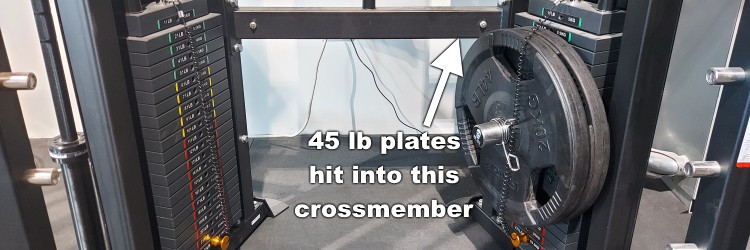
You can rule out this potential compatibility issue before you buy the Stacked Weight Pin:
- First, measure the radius of your biggest weight plate.
- Next, use that radius measurement to mark two reference points: One point to the left and another point to the right of one of the weight stack holes.
- Finally, make sure you have clearance above these reference points, through the full range of motion of the weight stack.
The final compatibility you should be aware of is only a minor one because it doesn’t actually stop you from using the Stacked Weight Pin:
Even if you have a weight stack guard that doesn’t impede the up-and-down range of motion, you will have to account for less usable sleeve length. The guard prevents you from setting the Olympic plates flush against the stack. You won’t be able to load as many plates on. The video clip below shows the reduced usable sleeve length when using a machine with a stack guard:
How to Pick the Right Stacked Weight Pin Size/Model?
Hopefully by now you’ve ruled out any serious compatibility issues. The next step is to select the right model for you.
There are 3 factors to consider here:
- Pin/rod diameter
- Sleeve length
- Pin/rod length
Pin/Rod Diameter
Let’s start with pin diameter (aka rod diameter). Most selectorized machines use either an 8mm or 10mm selector pin. That’s why Bare Steel Equipment makes the Stacked Weight Pin with either an 8mm or a 10mm rod.
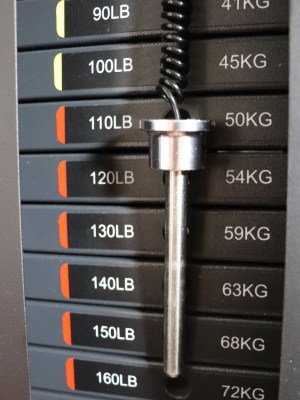
You should find out what size the selector pin is on the machine(s) you want to use. Ideally, you would use a caliper to measure the selector pin diameter. However, a ruler should do the trick if you carefully eye it.
If your weight stack uses an 8mm selector pin, then you have just 1 option:
- 8mm Stacked Weight Pin
If your weight stack uses a 10mm selector pin, then you have 2 options:
- 10mm Stacked Weight Pin
- Short Stack Weight Pin (10mm)
Then there’s the scenario where you plan to use the Stacked Weight Pin on multiple machines, with some using 8mm pins and others using 10mm pins. In this case, it may be wise to get the 8mm Stacked Weight Pin. It will work in both the 8mm and 10mm machines, even if the fit isn’t as tight on the 10mm ones.
Sleeve Size
Now, let’s talk sleeve size.
There are 2 sleeve size options.
- The 8mm and 10mm Stacked Weight Pins are both 6 inches long
- The Short Stack Weight Pin is 3 inches long
I recommend the longer Stacked Weight Pins to anyone with enough clearance for the 6 inch length. It’s always better to have more room to add plates than to not have enough.
However, if you only have enough clearance on your machine(s) for the shorter 3 inch sleeve, then the Short Stack Weight Pin is the one for you. However, this one only comes with a 10mm rod. If you need the short sleeve with an 8mm rod, then I recommend going with MiniPin from GymPin, which has the 8mm option.
Pin/Rod Length
The last thing to consider for sizing is the pin length (aka rod length). There are 2 different rod length options that Bare Steel Equipment offers:
- 3.65 inch rod length
- 4 inch rod length
The 3.65 inch rod works best for most machines with closed holes in the weight stack plates (i.e. holes that don’t go all the way through the plate). Closed hole plates have a shallower hole, and thus the shorter rod allows the sleeve to sit flush with the weight stack.
NOTE: Some closed-hole machines like those from Hoist have deeper holes and thus work better with the 4 inch rod.
The 4 inch rod works with best for machines with open holes in the weight stack plates (i.e. holes that go all the way through the weight plate.
UPDATE: Bare Steel Equipment now also offers 4.5″, 5″ and 6″ rod lengths, as well as custom rod lengths. Only choose a longer rod length if you’re sure your selectorized plates are deep enough. If you choose a length that’s too long and the rod extends through to the other side, it can potentially hit the weight stack panel guard. If you have open plate holes, I think a 4″ length is best for most people; it’s certainly the most versatile if you’ll be using it on multiple machines.
Other Insights
All in all, the Bare Steel Equipment Stacked Weight Pin is an excellently constructed piece of hardware. It makes adding weight to your stack effortless.
The only quirk, if you can even call it that, is that you’ll eventually need to add a barbell collar to the end to prevent the weights from sliding.
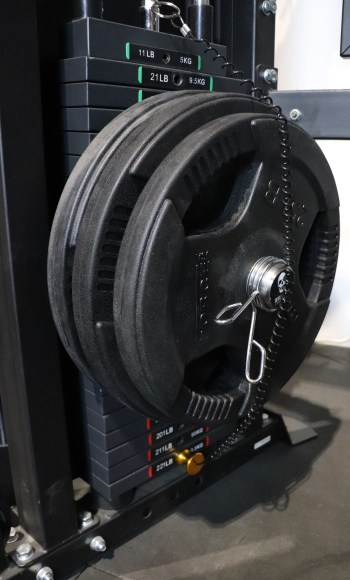
I was able to load 95 lbs pounds on with no collar and do a set of rows with fast reps, without the plates sliding — as shown below:
However, if I went much beyond this weight, some sliding would occur; though the plates wouldn’t necessarily fall off.
Note that the poundage at which sliding occurs will depend on your weight stack. I’m sure there are other weight stacks that may be stronger and thus able to keep parallel with heavier weights. However, if my weight stack was angling ever so slightly, chances are many others will, too.
Stacked Weight Pin Alternatives
Going above and beyond the maximum weight of a weight stack isn’t anything new. It’s just recently that the process has become streamlined with products like the Stacked Weight Pin.
One old trick is to stick a second weight selector pin in the weight stack. Then you hang plates off of it, as shown in this video:
You could also accomplish the same thing by sticking a long bolt or a screwdriver into the weight stack. I’ve even seen a guy use a belt to wrap an Olympic plate around the stack.
I’m sure there are plenty of other similar, crude methods for accomplishing this task.
Stacked Weight Pin vs GymPin
There’s really only one alternative on the same level as the Bare Steel Equipment Stacked Weight Pin…
…And that’s the GymPin. I actually did an in-depth GymPin review that you can read if you want all the details on it.
The GymPin was the first to come up with the elegant steel sleeve and pin design that both products share. Bare Steel Equipment took the design and made a few innovations.
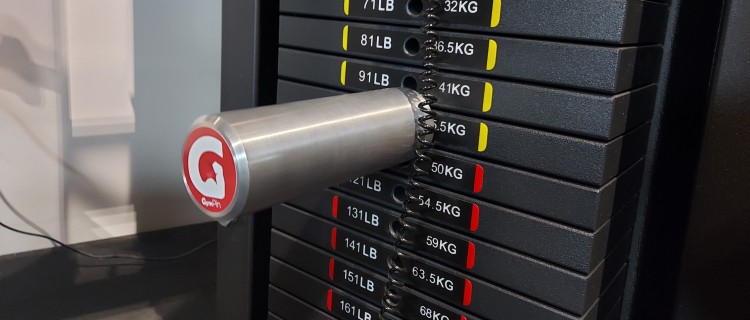
While these two competing products are quite similar, there are some key differences in features, specs, available models and price.
Here’s a breakdown of those differences to help you make a comparison between the two:
- The Stacked Weight Pin has magnets on the sleeve base for a more secure fit. The GymPin does not.
- The Stacked Weight Pin has optional cerakote finishes for the sleeve and TiN finishes for the rod. The GymPin only comes in bare steel at this time.
- The Stacked Weight Pin is significantly heavier than the GymPin. It depends on which models you’re comparing, but it’s about 2-2.5x as heavy. For example, the Stacked Weight Pin weighs just over 5 lbs, whereas the comparable Original GymPin weighs about 2 lbs.
- There aren’t as many models of the Stacked Weight Pin as there are of the GymPin. There is the 8mm Stacked Weight Pin, the 10mm Stacked Weight Pin and the Short Stack Weight Pin (which only comes in 10mm). Whereas, there is the Original GymPin (8mm and 10mm versions), the shorter MiniPin (8mm and 10mm versions), the extra long KingPin (10mm only) and the 1” GymPin for standard weight plates (8mm and 10mm versions)
- The Stacked Weight Pin costs more than the GymPin. Again the price difference varies depending on which models you’re comparing. But as an example, the 8mm Stacked Weight Pin costs $100. The 8mm GymPin costs £52 (equivalent to $71 at the time of writing this). Obviously, if you get any of the optional finishes, the price will be much higher for the Stacked Weight Pin.
So, which one should you buy?
I think the GymPin is a better value for most lifters. At the end of the day, both products are great and accomplish the same thing, but the GymPin’s lower price gives it an edge.
However, the Stacked Weight Pin is better for lifters who want the nice-to-have premium features like magnets that make it function more efficiently.
It’s certainly the go-to option for lifters who want optional custom finishes to personalize the aesthetics and/or to have better protection against rust and wear and tear.
I think you also have to consider where you’ll be training when deciding which brand to go with. I think the GymPin is better if you’re bringing it to a commercial gym because it’s lighter and thus more portable when carrying it in your gym bag.
If you really like the idea of using the pin as an incremental adder weight when progressing between weight stack settings, the Bare Steel Equipment models have the edge. This is because they’re heavier than the GymPin models. The Stacked Weight Pin is ~5 lbs, which is prefect because the typical selectorized plate is 10 lbs.
The Bare Steel Equipment models are also the better option if you’ll be using it on a machine with shallow closed plate holes. This is because all of their models are available with shorter 3.65 inch rods. All GymPin models have 4 inch rods only.
Lastly, you need to consider which model and/or size you need. Remember, the GymPin product line has more rod sizes and sleeve sizes. So, for example, if you want an extra short sleeve with an 8mm rod, you need to go with the GymPin MiniPin because the Short Stack Weight Pin only comes in 10mm. Similarly, if you want an extra long sleeve, the only brand that has one is the GymPin, with its KingPin model that has a nearly 8 inch sleeve.
Use Bare Steel Equipment Discount Code KING10 for $10 Off
Hopefully my Stacked Weight Pin review has helped you decide if it makes sense to buy this innovative gym accessory.
If you do get it, be sure to save $10 off by using my discount code KING10 at checkout.
Have fun making endless gains!

